Abstract
Fomites may play a role in the transmission of rotavirus infections, and in view of this, 27 disinfectants were evaluated for their ability to inactivate human rotavirus (HRV) on contaminated non-porous inanimate surfaces. Disks of stainless steel, glass and two types of plastics were contaminated with about 10(7) plaque-forming units of HRV suspended in faecal matter. The inoculum was allowed to dry and an equal volume of the product under test was applied to the contaminated surface. After contact for 1 min, the action of the disinfectant was stopped by dilution. Surviving infectious virus on the disks was determined by plaque assay in MA-104 cells. A product was considered to be effective if it could reduce the virus titre by at least 3 log10. Only 33.3% (9/27) of the formulations tested proved to be effective. Further testing of the effective products, which included antiseptics, instrument soaks and hard-surface disinfectants, showed that all of them could, in fact, reduce the virus titre on contaminated surfaces by at least 6 log10. These findings show the relative resistance of HRV to a wide range of chemical disinfectants in common use, and also emphasize the need for a more thorough evaluation of the virucidal potential of formulations regularly employed in attempts to prevent and control outbreaks of rotaviral diarrhoea.
Full text
PDF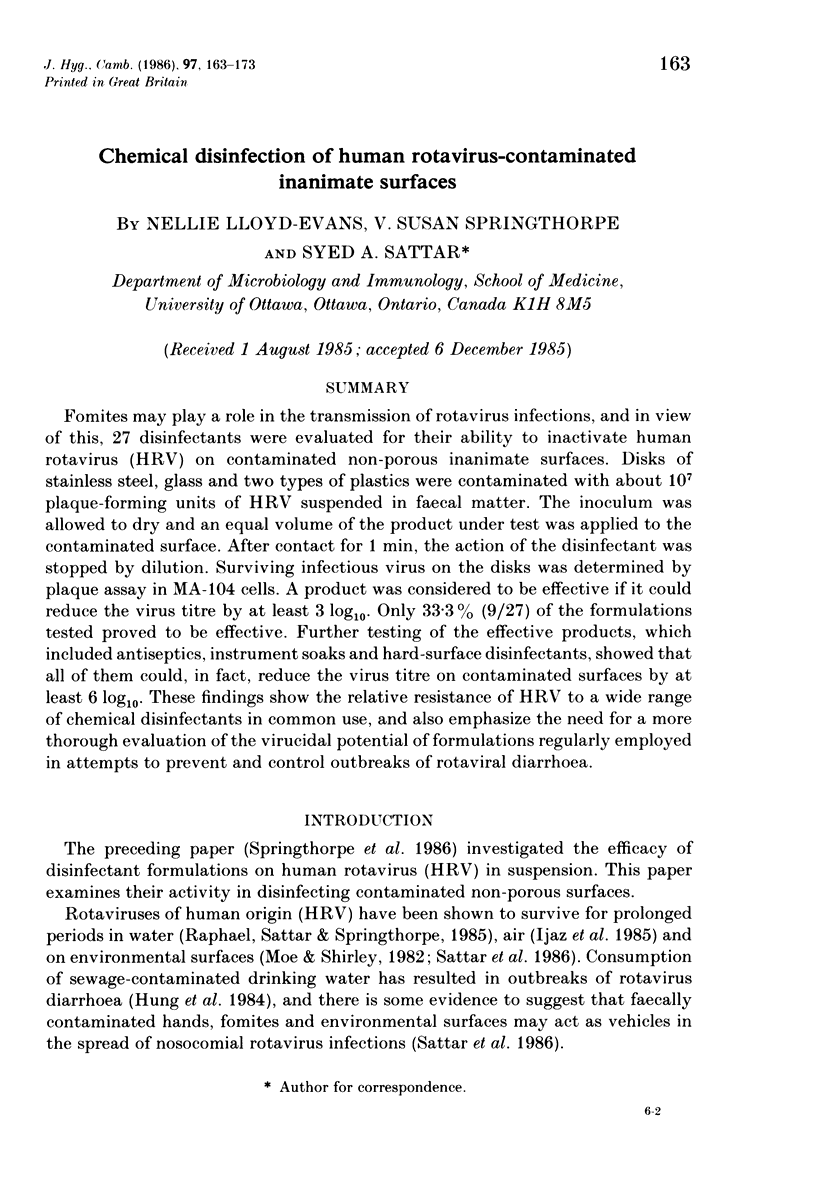
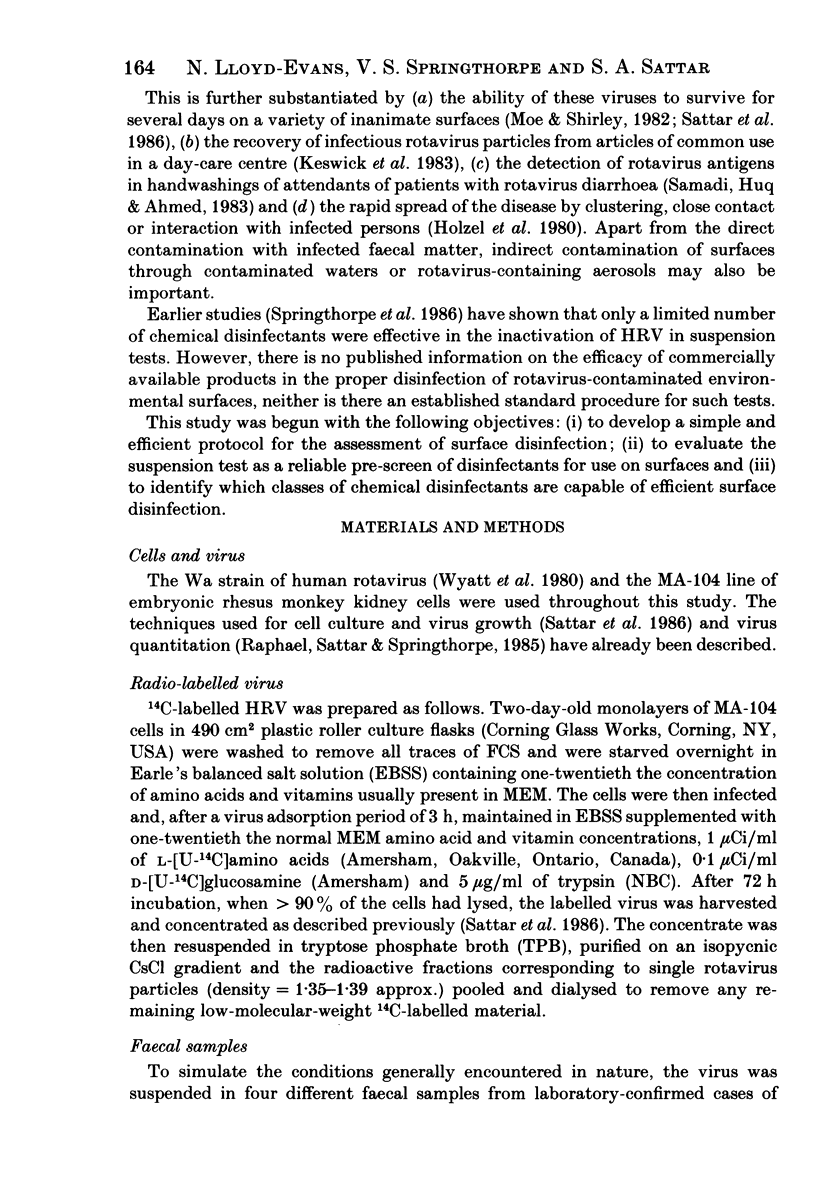
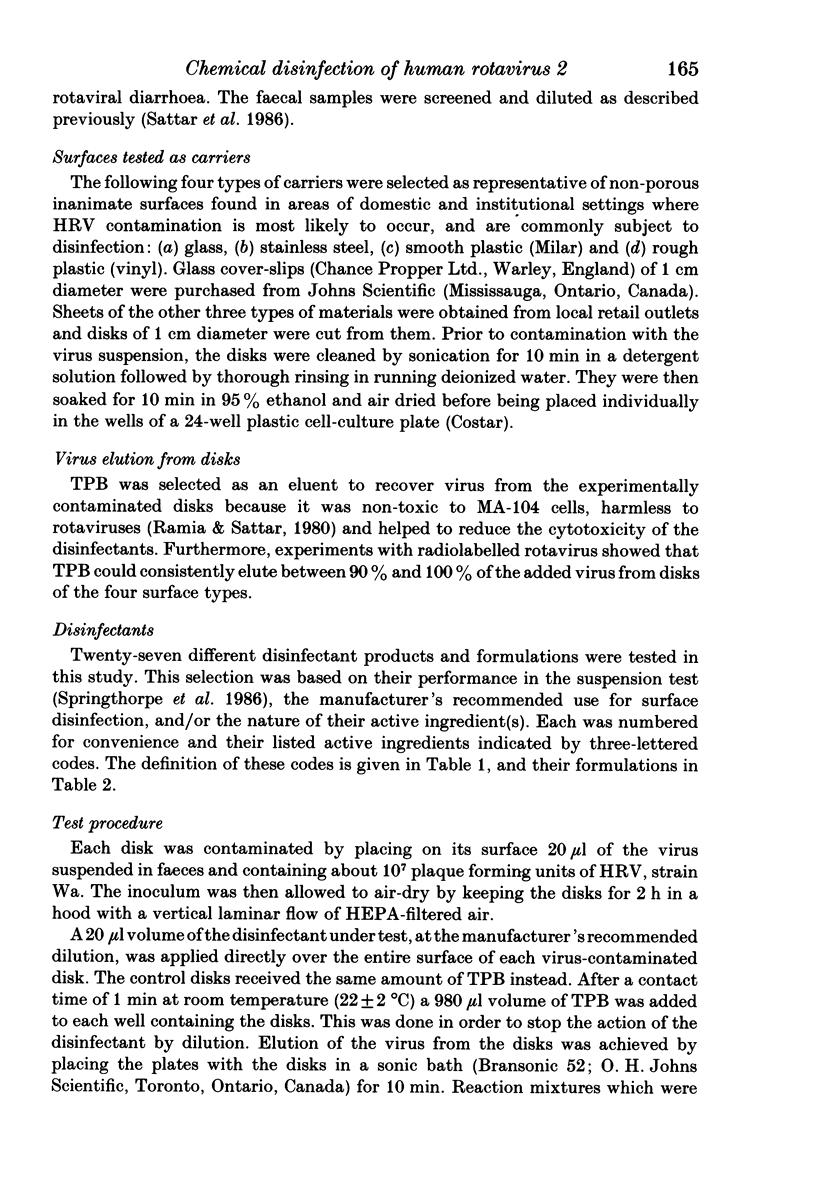
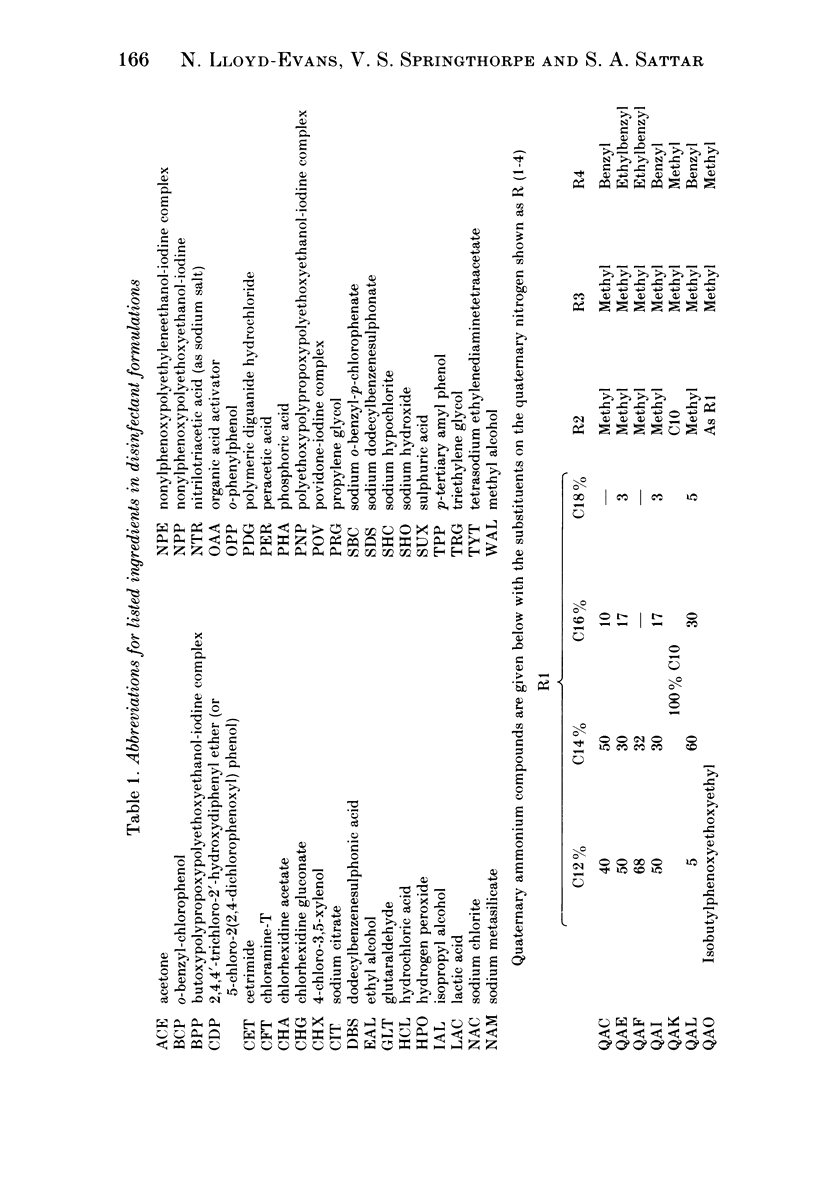
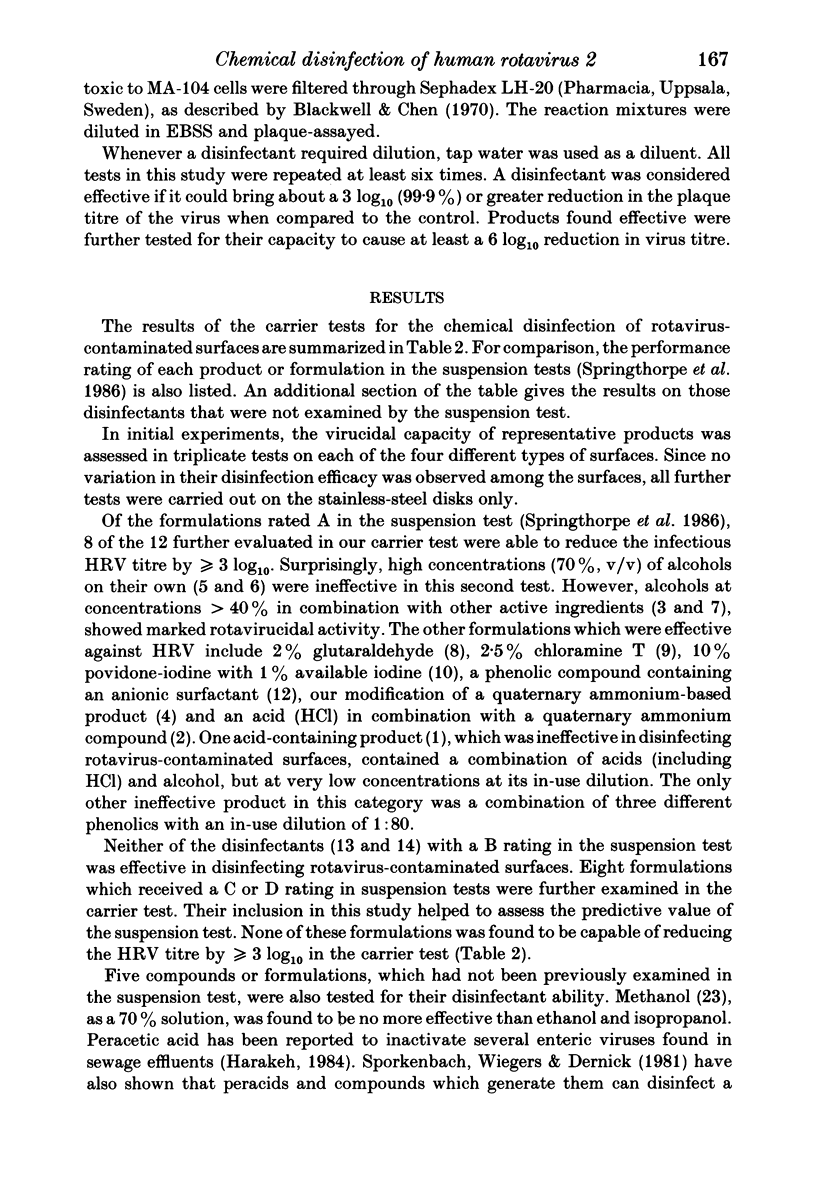
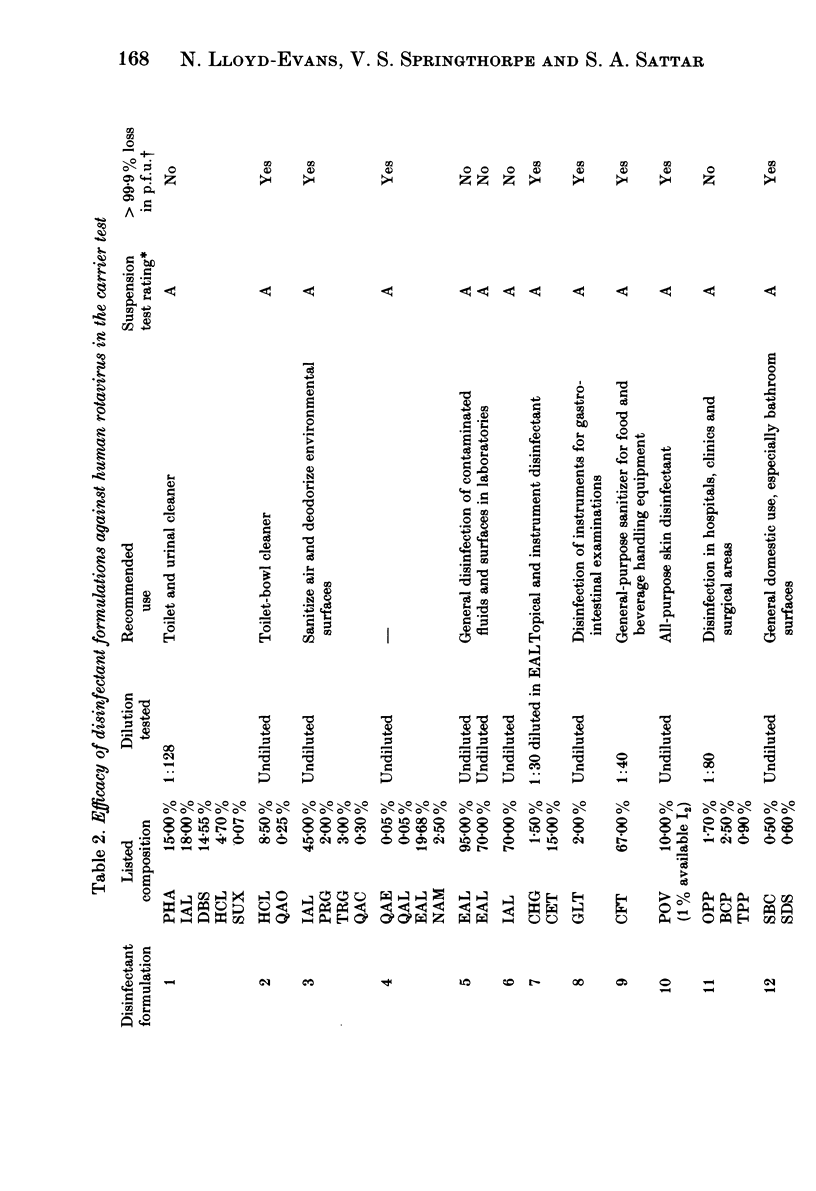
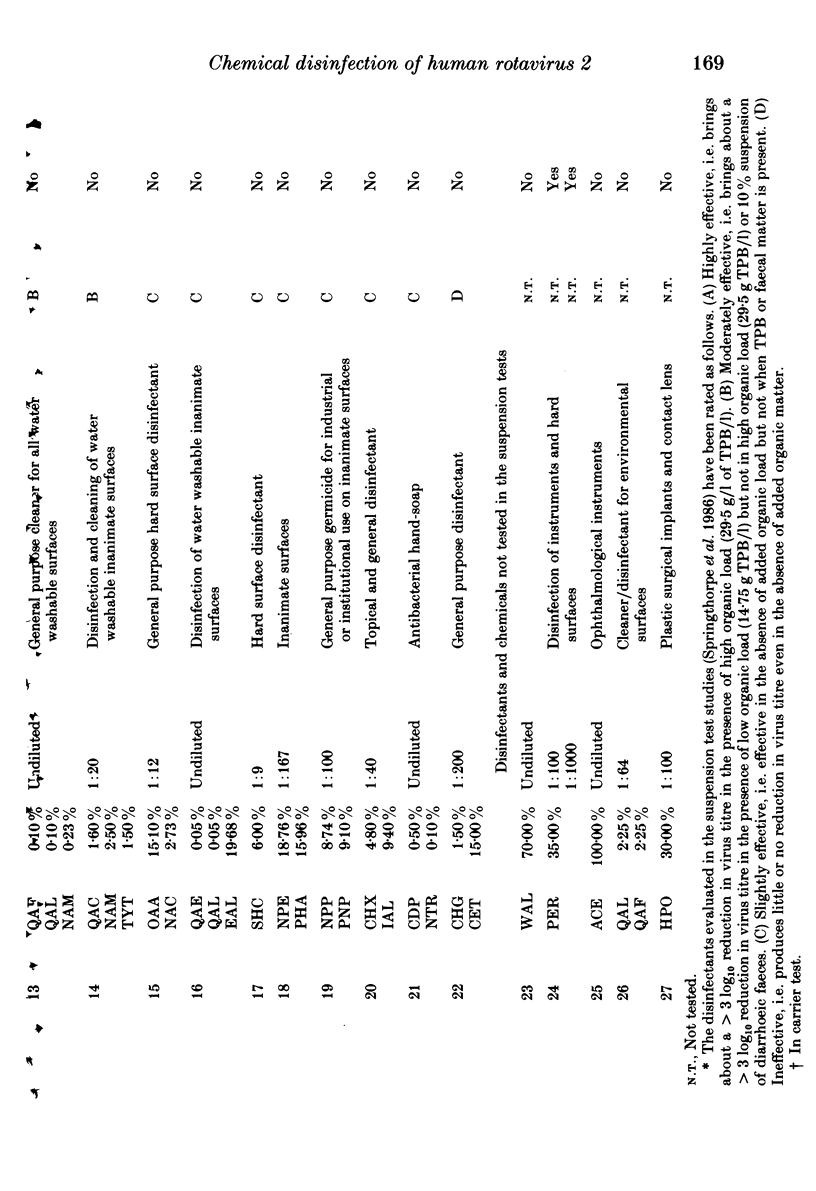
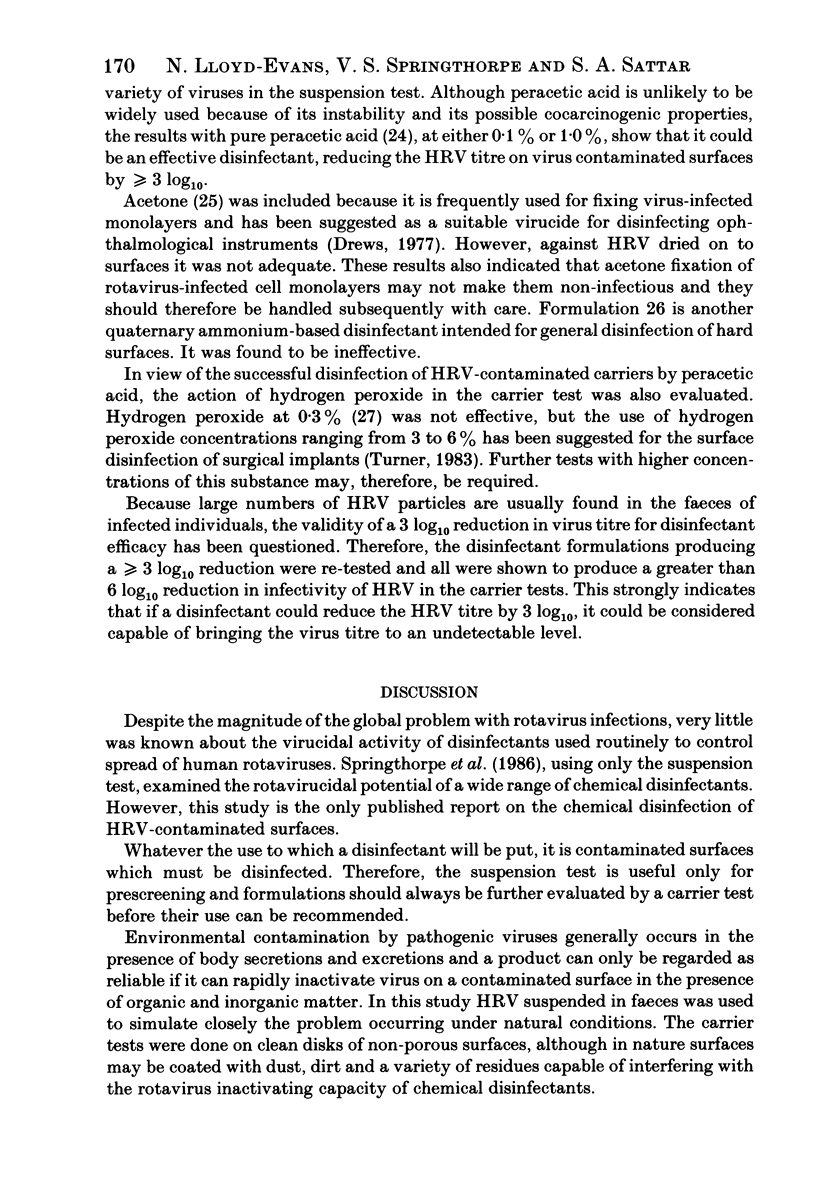
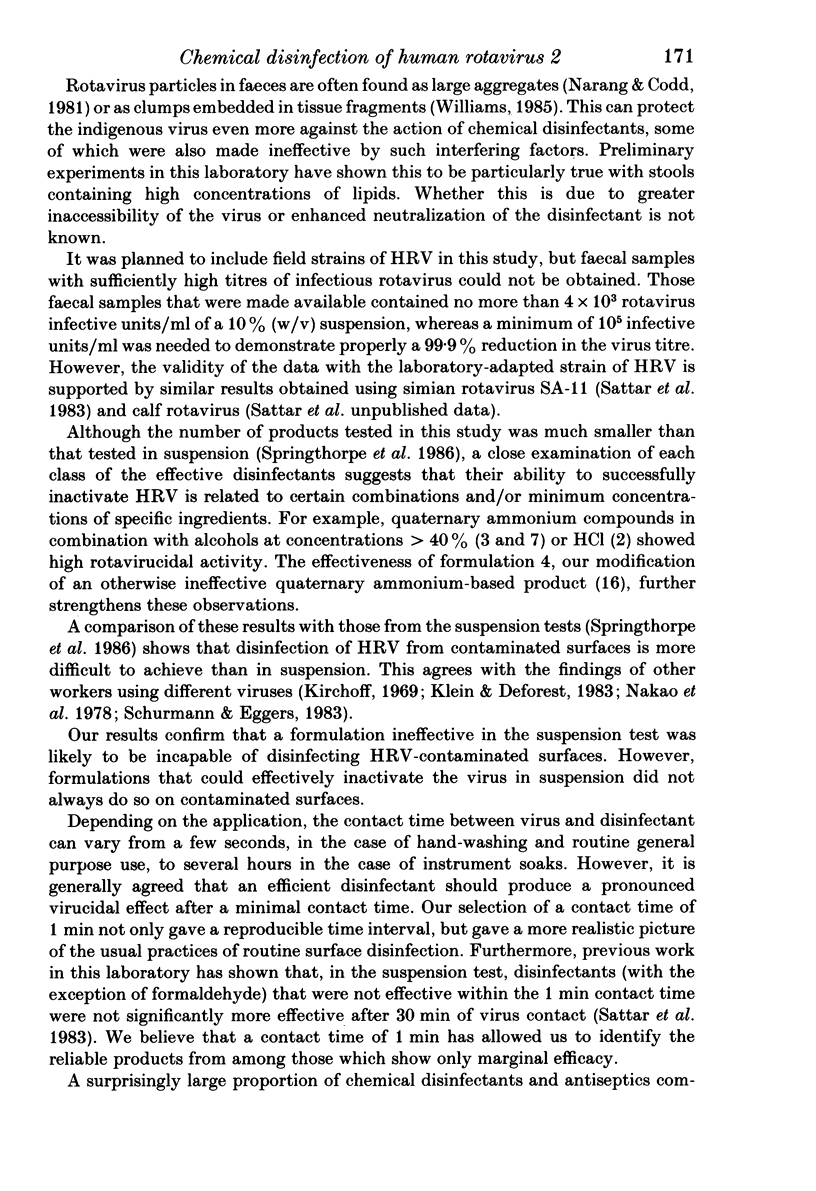
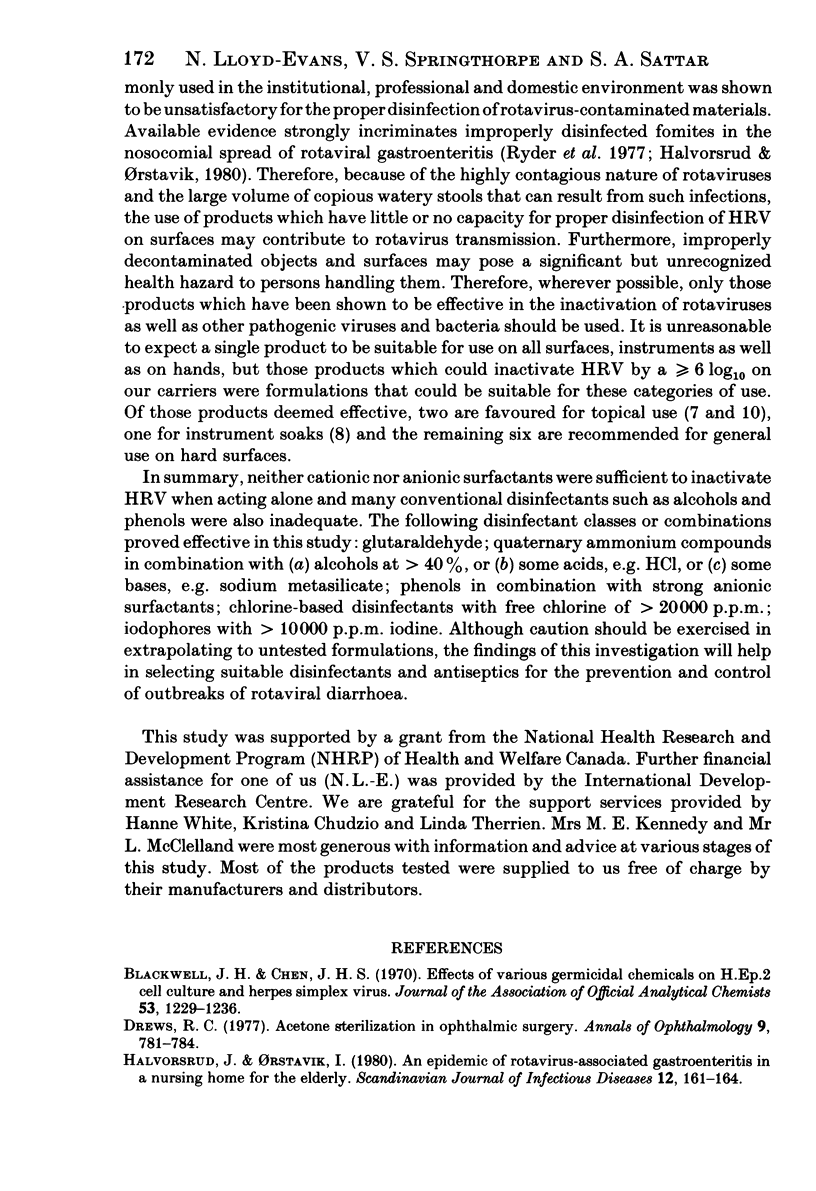
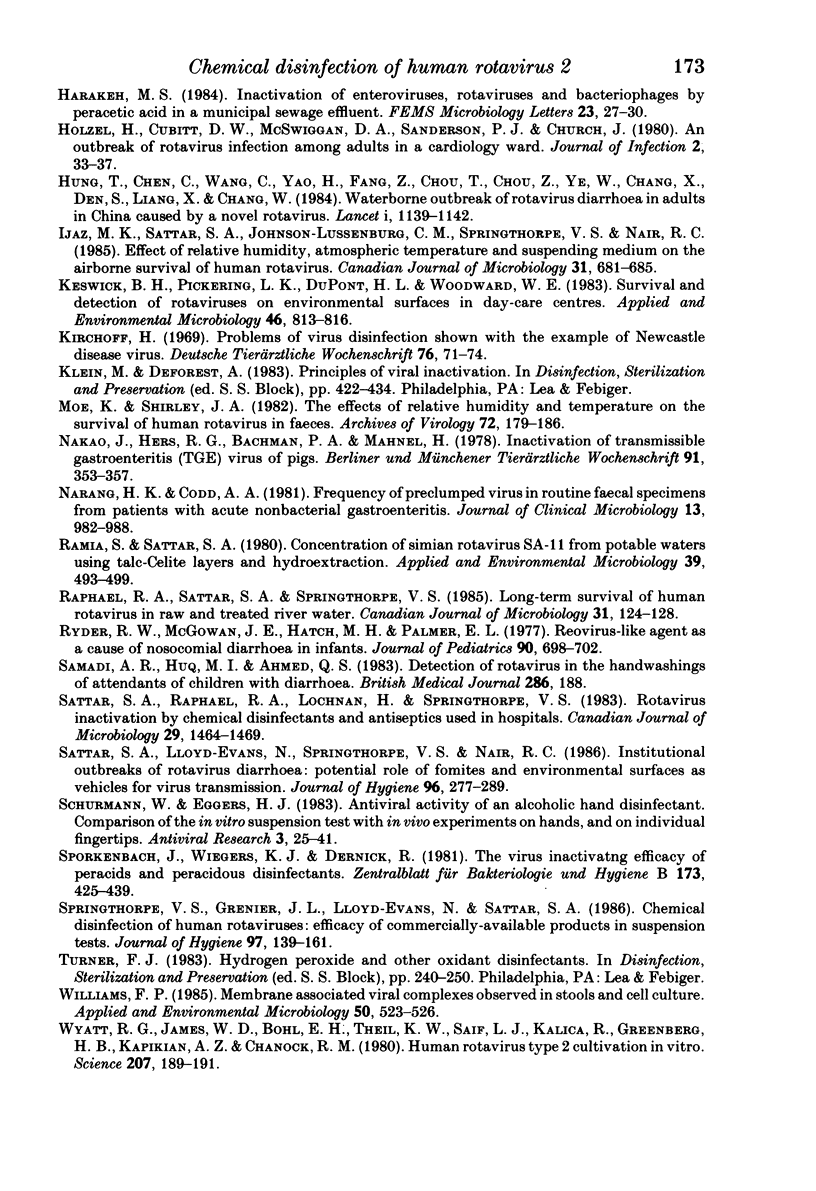
Selected References
These references are in PubMed. This may not be the complete list of references from this article.
- Drews R. C. Acetone sterilization in ophthalmic surgery. Ann Ophthalmol. 1977 Jun;9(6):781–784. [PubMed] [Google Scholar]
- Halvorsrud J., Orstavik I. An epidemic of rotavirus-associated gastroenteritis in a nursing home for the elderly. Scand J Infect Dis. 1980;12(3):161–164. doi: 10.3109/inf.1980.12.issue-3.01. [DOI] [PubMed] [Google Scholar]
- Holzel H., Cubitt D. W., McSwiggan D. A., Sanderson P. J., Church J. An outbreak of rotavirus infection among adults in a cardiology ward. J Infect. 1980 Mar;2(1):33–37. doi: 10.1016/s0163-4453(80)91750-8. [DOI] [PubMed] [Google Scholar]
- Hung T., Chen G. M., Wang C. G., Yao H. L., Fang Z. Y., Chao T. X., Chou Z. Y., Ye W., Chang X. J., Den S. S. Waterborne outbreak of rotavirus diarrhoea in adults in China caused by a novel rotavirus. Lancet. 1984 May 26;1(8387):1139–1142. [PubMed] [Google Scholar]
- Ijaz M. K., Sattar S. A., Johnson-Lussenburg C. M., Springthorpe V. S., Nair R. C. Effect of relative humidity, atmospheric temperature, and suspending medium on the airborne survival of human rotavirus. Can J Microbiol. 1985 Aug;31(8):681–685. doi: 10.1139/m85-129. [DOI] [PubMed] [Google Scholar]
- Keswick B. H., Pickering L. K., DuPont H. L., Woodward W. E. Survival and detection of rotaviruses on environmental surfaces in day care centers. Appl Environ Microbiol. 1983 Oct;46(4):813–816. doi: 10.1128/aem.46.4.813-816.1983. [DOI] [PMC free article] [PubMed] [Google Scholar]
- Moe K., Shirley J. A. The effects of relative humidity and temperature on the survival of human rotavirus in faeces. Arch Virol. 1982;72(3):179–186. doi: 10.1007/BF01348963. [DOI] [PubMed] [Google Scholar]
- Nakao J., Hess R. G., Bachmann P. A., Mahnel H. Zur Widerstandsfähigkeit und Inaktivierung des Virus der übertragbaren Gastroenteritis (TGE) der Schwiene. Berl Munch Tierarztl Wochenschr. 1978 Sep 15;91(18):353–357. [PubMed] [Google Scholar]
- Narang H. K., Codd A. A. Frequency of preclumped virus in routine fecal specimens from patients with acute nonbacterial gastroenteritis. J Clin Microbiol. 1981 May;13(5):982–988. doi: 10.1128/jcm.13.5.982-988.1981. [DOI] [PMC free article] [PubMed] [Google Scholar]
- Ramia S., Sattar S. A. Concentration of seeded simian rotavirus SA-11 from potable waters by using talc-celite layers and hydroextraction. Appl Environ Microbiol. 1980 Mar;39(3):493–499. doi: 10.1128/aem.39.3.493-499.1980. [DOI] [PMC free article] [PubMed] [Google Scholar]
- Raphael R. A., Sattar S. A., Springthorpe V. S. Long-term survival of human rotavirus in raw and treated river water. Can J Microbiol. 1985 Feb;31(2):124–128. doi: 10.1139/m85-024. [DOI] [PubMed] [Google Scholar]
- Ryder R. W., McGowan J. E., Hatch M. H., Palmer E. L. Reovirus-like agent as a cause of nosocomial diarrhea in infants. J Pediatr. 1977 May;90(5):698–702. doi: 10.1016/s0022-3476(77)81230-4. [DOI] [PubMed] [Google Scholar]
- Samadi A. R., Huq M. I., Ahmed Q. S. Detection of rotavirus in handwashings of attendants of children with diarrhoea. Br Med J (Clin Res Ed) 1983 Jan 15;286(6360):188–188. doi: 10.1136/bmj.286.6360.188. [DOI] [PMC free article] [PubMed] [Google Scholar]
- Sattar S. A., Lloyd-Evans N., Springthorpe V. S., Nair R. C. Institutional outbreaks of rotavirus diarrhoea: potential role of fomites and environmental surfaces as vehicles for virus transmission. J Hyg (Lond) 1986 Apr;96(2):277–289. doi: 10.1017/s0022172400066055. [DOI] [PMC free article] [PubMed] [Google Scholar]
- Sattar S. A., Raphael R. A., Lochnan H., Springthorpe V. S. Rotavirus inactivation by chemical disinfectants and antiseptics used in hospitals. Can J Microbiol. 1983 Oct;29(10):1464–1469. doi: 10.1139/m83-225. [DOI] [PubMed] [Google Scholar]
- Schürmann W., Eggers H. J. Antiviral activity of an alcoholic hand disinfectant. Comparison of the in vitro suspension test with in vivo experiments on hands, and on individual fingertips. Antiviral Res. 1983 Mar;3(1):25–41. doi: 10.1016/0166-3542(83)90012-8. [DOI] [PubMed] [Google Scholar]
- Sporkenbach J., Wiegers K. J., Dernick R. Die virusinaktivierende Wirkung von Persäuren und Persauren Desinfektionsmitteln. Zentralbl Bakteriol Mikrobiol Hyg B. 1981 Sep;173(6):425–439. [PubMed] [Google Scholar]
- Springthorpe V. S., Grenier J. L., Lloyd-Evans N., Sattar S. A. Chemical disinfection of human rotaviruses: efficacy of commercially-available products in suspension tests. J Hyg (Lond) 1986 Aug;97(1):139–161. doi: 10.1017/s0022172400064433. [DOI] [PMC free article] [PubMed] [Google Scholar]
- Williams F. P., Jr Membrane-associated viral complexes observed in stools and cell culture. Appl Environ Microbiol. 1985 Aug;50(2):523–526. doi: 10.1128/aem.50.2.523-526.1985. [DOI] [PMC free article] [PubMed] [Google Scholar]
- Wyatt R. G., James W. D., Bohl E. H., Theil K. W., Saif L. J., Kalica A. R., Greenberg H. B., Kapikian A. Z., Chanock R. M. Human rotavirus type 2: cultivation in vitro. Science. 1980 Jan 11;207(4427):189–191. doi: 10.1126/science.6243190. [DOI] [PubMed] [Google Scholar]


